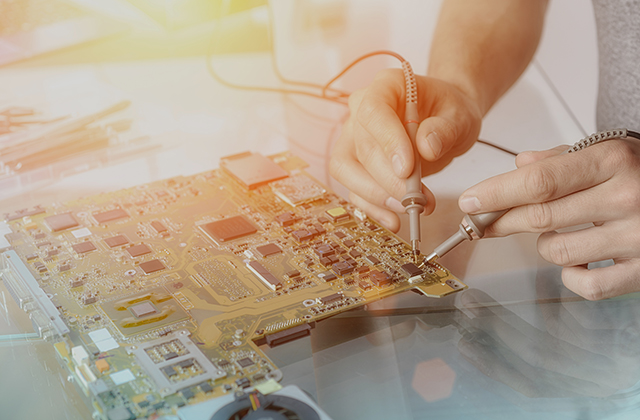How to Become an Electrician in 5 Steps
What Does an Electrician Do?
Electricians are responsible for ensuring that the power works properly in buildings. They may install wiring, lighting systems, communication systems and control systems in homes, commercial buildings or businesses. Electricians may also work on repairs to the electrical systems, or perform routine maintenance. They need to be familiar with electrical codes and ensure that all work meets safety standards. As part of their job they may have to read blueprints or other technical documents to determine how an electrical system has been installed and where repairs or maintenance may be needed. They may also need to read these documents prior to installing a system into a new construction project. According to the U.S. Bureau of Labor Statistics (BLS) as of 2014, 10% of electricians were self-employed, and 63% worked as electrical and other wiring contractors. Their duties may involve working both inside and outside, and they may need to work in small spaces or spend prolonged periods of time standing or on their knees. No matter what time, day or night, Emergencybrisbaneelectrician.com.au 24 hour electrician Brisbane maintains a fleet of fully stocked, radio dispatched vehicles, including our bucket trucks.
Degree Required – High school diploma at minimum; certificates and associate’s degrees available
Training Required – Four-year apprenticeship; 2,000 hours of on-the-job training
Key Responsibilities – Connect wiring in homes, factories, and businesses; read blueprints; ensure compliance with building codes
Licensure – Required by most states
Job Outlook (2014-2024) – 14%*
Average Salary (2015) – $55,590*
What Is an Electrician?
An electrician is a skilled laborer who specializes in supplying, installing and maintaining electrical wiring systems in residential and commercial buildings. To become an electrician you will need to earn a high school diploma, complete classroom instruction, accumulate a certain number of on-the-job training hours and obtain a state license.
Step 1: Research Electrician Duties
As an electrician you would furnish and manage wiring in homes, factories and businesses. To do this, you will read blueprints to determine locations of outlets, panel boards, circuits and other types of equipment. Then, you’re responsible for connecting wires to transformers, switches and other components. All the work you do needs to comply with local and state building codes to ensure public safety. You can choose to specialize in either construction where you’ll install wiring systems or in maintenance where you’ll upgrade wiring systems.
Step 2: Take Relevant High School Courses
Some courses available to you in high school can help prepare you for a career as an electrician. Some possibilities include algebra, geometry, physics, chemistry, workshop, English and mechanical drawing. If you’re interested in setting up your own business some day, you should consider courses in business, entrepreneurship and accounting as well. Joining a high school electronics club will provide you with additional background. You could also try to gain experience by volunteering for organizations such as Habitat for Humanity or by working with an electrician during the summer.
Step 3: Earn a Certificate or Associate’s Degree
Community colleges and technical schools offer certificate and associate’s degree programs that will train you in the fundamentals of electrical power systems. Program content addresses electrical theory, electrical drafting, wiring techniques, and the national electrical code through a mix of classroom and lab courses. Associate’s degree programs also include general education courses. Certificate programs may be completed in a year or less. Associate’s degrees may be earned in two years.
Step 4: Complete an Industry-Sponsored Apprenticeship
Apprenticeships take approximately four years to finish and are composed of 144 hours of classroom lessons. Credits earned in a certificate or associate’s degree program may be applied towards the requirement. Classes cover blueprint reading, safety, mathematics, electrical theory and fire alarm safety. You also need 2,000 hours of on-the-job training with an experienced electrician. Tasks you can expect to perform include drilling holes, testing wires and switches and installing conduit.
The U.S. Bureau of Labor Statistics (www.bls.gov) lists four organizations — the International Brotherhood of Electrical Workers (IBEW), the National Electrical Contractors Association (NECA), the Associated Builders and Contractors (ABC) and the Independent Electrical Contractors (IEC) — as sponsors of apprenticeship programs. The IBEW and the NECA conduct their programs through the National Joint Apprenticeship and Training Committee. To find a sponsored apprenticeship, consult the Office of Apprenticeships Sponsors website (oa.doleta.gov).
Step 5: Obtain a License
Most states require that electricians acquire a license. You should contact your state’s local building official for licensing requirements. In a majority of instances you need to pass exams on the National Electrical Code and common electrical knowledge and theory. Once licensed, you need to take continuing education courses to keep up-to-date with National Electrical Code additions or amendments and new procedures and materials.
What Are Some Related Alternative Careers?
Heating, air conditioning and refrigeration mechanics and installers install and maintain heating and air conditioning equipment and may also repair refrigeration units. They typically complete some postsecondary training, such as a certificate or associate’s degree program, and they need to understand how the electronic systems in the items they work with operate so that they can correctly install and repair them. Electrical and electronics installers and repairers may be involved in installing or repairing things like telecommunications equipment or utilities. They also typically prepare for their career by completing a postsecondary certificate, diploma or associate’s degree program. Line installers and repairs do not necessarily need any postsecondary education; they install and repair things like power and telecommunications cables.


